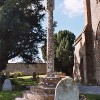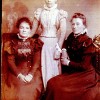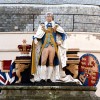Sydney Smith was born on 14th of July 1839 in South Street, Dorchester, the second of three sons born to Frederick and Helen Smith. He was destined for a career and fame in the world of music. Like his older brother, Frederick, he followed in the steps of his father who was a professor of music and dance. Their younger brother, Walter, trained as an assistant bookseller; he died aged just 25 years.
The parents of these three boys, Frederick Smith and Helen Boyton came to Dorset shortly after their marriage at Clifton, Bristol. Frederick Smith was originally from Deal in Kent and Helen Boyton from Clifton. Their father died in 1870 and is buried in Dorchester Cemetery. Sydney’s brothers Frederick and Walter are buried next to their father.
Sydney and his brother received their early musical tuition from their parents. Notices in the Dorset Chronicle in the late 1840’s refer to a series of concerts given by Frederick Smith (on violin) with his sons Boyton (on piano) and Master Sydney (on ‘cello.) [Frederick also had his mother’s maiden name and was known as Boyton Smith.]
In 1855, possibly as the result of winning a Mendelssohn scholarship, Sydney had a place at the famous Leipzig conservatory; he was sixteen. He spent the following three years there studying piano and cello.
Returning to Dorchester in 1858 his talent was recognised by the eminent violinist, Henry Blagrove, who had once been in the employ of Queen Adelaide and was later associated with the Royal Academy of Music. A year later following advice from Blagrove he moved to London and found lodgings in Upper Seymour Street. He quickly established a name for himself as a recitalist and was much in demand in society circles as a teacher of the piano. There followed the best part of three decades when his name was a household word; in today’s world he would have been a much sought after celebrity.
In 1867 Sydney married Hanna Birch. She was originally from Buckinghamshire and the daughter of a druggist in business at George Street, London W.l. She was a singer with the choir of the Philharmonic Society which is probably where the couple met. A year later at 45, Blandford Square, London, their first daughter was delivered and baptised Blanch Edith.
A son, Leonard Sydney, was born to the couple in 1870 and their daughter Linda May was born in 1872. The following year they lost their first child, Blanch, to rheumatic fever and another son, Granville Boyton Sydney was born, followed in 1875 by Eustace and their last child was born in 1878.
In 1886 Hanna died of Bright’s disease after five years of failing health. She was buried at Kensal Green Cemetery on the 16th of July 1886 in the grave of her first daughter. According to her death certificate her passing was notified to the registrar by Blanche Augustine Pinget. Miss Pinget was 25 and had nursed Hanna through her last days but she had an earlier association with the family when she was nurse to the Smith’s children.
Possibly there was more to this relationship because a little over a year after Hanna’s death Blanche Augustine Pinget became the second Mrs Smith at a ceremony at St. John’s Parish Church, Hampstead on the 28th of October 1887. After their marriage the couple lived at 28 Birchington Road, Kilburn.
This move from the fashionable heart of London may have been forced on the couple. Sydney was suffering from a “severe malignant tumour of the spine and ribs.” He had to give up his teaching and concert career which would have resulted in a considerable drop in income and there were no royalties to rely on although he had composed nearly 400 works.
Celebrity quickly dims and this was certainly the case for Sydney Smith. The tragic illness and the resulting hardship forced him to apply to The Royal Society of Musicians for assistance and they helped in a small way.
Sydney Smith, in his day a famous composer of popular music, was buried with Hanna, his first wife and his daughter Blanch in a grave marked by an un-inscribed cross. His star diminished by the changes in musical taste at the end he merited a short obituary in The Musical Times. He is remembered today in musical circles; his work, and that of his contemporaries is kept alive by the Sydney Smith Archive.
We have placed a photograph of Sydney Smith in the photo section.



